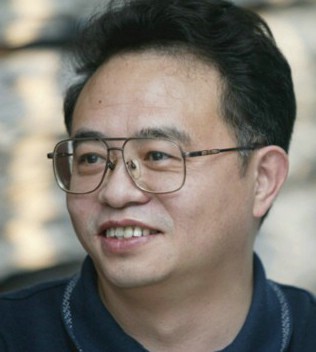
2014年11月15-16日 长沙 (与CCPR2014 一同召开)
模式识别一直以来是计算机和自动化学科的研究热点,也是各种智能应用的关键技术,如视频监控、图像搜索、移动增强现实、智能问答系统等。这是一个跨学科的领域,牵涉到机器学习、统计计算、优化算法、图像/视频处理、语音语言处理等。模式识别正处在一个基础研究和应用研究爆发的时期。随着智能设备和物联网的不断发展,模式识别具有更广阔的研究和应用前景。
本次模式识别讲习班与 CCPR 2014 一同召开,邀请到模式识别领域知名的专家学者做主题报告,希望能对从事该领域的学生、老师和工业界研究人员有所帮助。本讲习班将对模式识别的热点理论和方法、重点应用研究进行介绍,使参加者在了解学科热点、提高学术水平的同时,增加交流机会和实践体验。“工欲善其事,必先利其器”,我们相信这次讲习班将有助于大家未来的研究工作。
学术主任:王 亮 中科院自动化所研究员
主办单位:模式识别国家重点实验室
协办单位:湖南大学
(按姓名拼音排序)

题目:Probabilistic Graphical Models and Their Applications in Computer Vision
摘要:
Probabilistic graphical models (PGMs) have been increasingly applied to solve many computer vision problems, thanks mainly to their powerful capability in representing various types of visual knowledge as well as to the availability of principled statistical theories and algorithms for inference and learning. Under probabilistic models, data are modeled as a collection of random variables with a particular pattern of possible dependencies among them. Using the model, we can then discover knowledge, predict future events, and infer hidden causes. In this lecture, I will first introduce different types of PGMs including directed PGMs such as Bayesian Networks, Hidden Markov Models, and Dynamic Bayesian Networks as well as undirected PGMs such as Markov Networks, Conditional Random Fields, and Restricted Boltzmann Machine. I will then discuss various PGM learning and inference methods, including both parameter and structure learning as well as both exact and approximate inference methods. The second part of this lecture will cover the applications of PGMs to computer vision. These applications include image segmentation, facial expression recognition, object tracking, and human action/activity recognition. This lecture will conclude with a discussion of remaining issues and future directions in PGM research and in its application in computer vision.
讲者简介
Qiang Ji received his Ph.D degree in Electrical Engineering from the University of Washington. He is currently a Professor with the Department of Electrical, Computer, and Systems Engineering at Rensselaer Polytechnic Institute (RPI). From 2009 to 2010, he served as a program director at the National Science Foundation (NSF), where he managed NSF’s computer vision and machine learning programs. He also held teaching and research positions with the Beckman Institute at University of Illinois at Urbana-Champaign, the Robotics Institute at Carnegie Mellon University, the Dept. of Computer Science at University of Nevada at Reno, and the US Air Force Research Laboratory. Prof. Ji currently serves as the director of the Intelligent Systems Laboratory (ISL) at RPI.
Prof. Ji's research interests are in computer vision, probabilistic graphical models, information fusion, and their applications in various fields. He has published over 200 papers in peer-reviewed journals and conferences. He has won several awards from IEEE and other international journal and conferences. His research has been supported by major governmental agencies including NSF, NIH, DARPA, ONR, ARO, and AFOSR as well as by major companies. Prof. Ji is an editor on several related IEEE and international journals and he has served as a general chair, program chair, technical area chair, and program committee member in numerous international conferences/workshops. Prof. Ji is a fellow of IAPR

报告题目:Introduction to Deep Learning and its applications in Computer Vision
摘要:
Deep learning has become a major breakthrough in artificial intelligence and achieved amazing success on solving grand challenges in many fields including computer vision. Its success benefits from big training data and super parallel computational power emerging in recent years, as well as advanced model design and training strategies. In this talk, I will try to introduce deep learning and explain the magic behind it. Through concrete examples of computer vision applications, I will illustrate four key points about deep learning. (1) Different than traditional pattern recognition systems, which heavily rely on manually designed features, deep learning automatically learns hierarchical feature representations from data and disentangles hidden factors of input data through multi-level nonlinear mappings. (2) Different than existing pattern recognition systems which sequentially design or training their key components, deep learning is able to jointly optimize all the components and crate synergy through close interactions among them. (3) While most machine learning tools can be approximated with neural networks with shallow structures, for some tasks, the expressive power of deep models increases exponentially as their architectures go deep. (4) Benefitting the large learning capacity of deep models, we also recast some classical computer vision challenges as high-dimensional data transform problems and solve them from new perspectives. Some open questions related to deep learning will also be discussed in the end.
讲者简介:
Xiaogang Wang received his Bachelor degree in Electrical Engineering and Information Science from the Special Class of Gifted Young at the University of Science and Technology of China in 2001, M. Phil. degree in Information Engineering from the Chinese University of Hong Kong in 2004, and PhD degree in Computer Science from Massachusetts Institute of Technology in 2009. He is an assistant professor in the Department of Electronic Engineering at the Chinese University of Hong Kong since August 2009. He received the Outstanding Young Researcher in Automatic Human Behaviour Analysis Award in 2011, Hong Kong RGC Early Career Award in 2012, and Young Researcher Award of the Chinese University of Hong Kong. He is the associate editor of the Image and Visual Computing Journal. He was the area chair of ICCV 2011, ECCV 2014 and ACCV 2014. His research interests include computer vision, deep learning, crowd video surveillance, object detection, and face recognition.

题目: PASCAL VOC Classification Challenge: 2010-2014
摘要:
In this talk, we shall summarize the progress of PASCAL VOC classification challenge from 2010 to 2014, namely how the performance is step-by-step improved from 0.73 to above 0.90.
The contents include:
Contextualizing object classification and detection;
Hierarchical pooling;
Sub-category mining;
Hypothesis-CNN-Pooling framework.
Also live demo shall be presented to demonstrate the state-of-the-art performance.
讲者简介:
Dr. Yan Shuicheng is currently an Associate Professor at the Department of Electrical and Computer Engineering at National University of Singapore, and the founding lead of the Learning and Vision Research Group (http://www.lv-nus.org). Dr. Yan's research areas include machine learning, computer vision and multimedia, and he has authored/co-authored nearly 400 technical papers over a wide range of research topics, with Google Scholar citation >12,000 times. He is ISI highly-cited researcher 2014, and IAPR Fellow 2014. He has been serving as an associate editor of IEEE TKDE, CVIU and TCSVT. He received the Best Paper Awards from ACM MM'13 (Best Paper and Best Student Paper), ACM MM’12 (Best Demo), PCM'11, ACM MM’10, ICME’10 and ICIMCS'09, the runner-up prize of ILSVRC'13, the winner prizes of the classification task in PASCAL VOC 2010-2012, the winner prize of the segmentation task in PASCAL VOC 2012, the honorable mention prize of the detection task in PASCAL VOC'10, 2010 TCSVT Best Associate Editor (BAE) Award, 2010 Young Faculty Research Award, 2011 Singapore Young Scientist Award, and 2012 NUS Young Researcher Award.

题目:Structured 2D Methods for Feature Extraction and Classification
摘要:
2DPCA has been a popular method for image feature extraction. In this talk, we first give an overview 2DPCA: its algorithm and properties. We know that2DPCA can be equivalently implemented via image-row based 1D PCA because it uses the F-norm. We then presents a structured 2D PCA method, namely, nuclear norm based 2DPCA (N-2DPCA). N-2DPCA uses a nuclear norm based reconstruction error criterion. The nuclear norm is a matrix norm, which provides a structured 2D characterization for the reconstruction error. Finally, we talk about our new work: nuclear norm based structured 2D regression. The method is used to design a classifier for robust face recognition.
讲者简介:
2002年7月博士毕业于南京理工大学计算机学院模式识别专业。自2003年起,先后在西班牙萨拉戈萨大学、香港理工大学、美国新泽西理工学院、加州理工学院从事博士后或访问研究。2007年9月起任南京理工大学计算机学院教授,2014年3月起任南京理工大学计算机科学与工程学院副院长。
长期从事模式识别理论与应用方面的研究,先后主持了国家自然科学基金面上项目,国家杰出青年科学基金项目,教育部科学技术研究重大项目,国家973课题等项目。在模式识别和机器智能领域的顶级国际期刊 IEEE Trans. on PAMI上发表论文3篇,在其他IEEE Transactions及Pattern Recognition等国际SCI源期刊上发表论文70余篇。SCI被引用3000余次,Google Scholar被引用6000余次。现担任国际SCI源学术期刊的IEEE Trans. on Neural Networks and Learning Systems和Pattern Recognition Letters的编委。
曾获国家自然科学二等奖(第二完成人);江苏省科技进步一等奖(第二完成人);教育部科技进步奖(推广类) 二等奖(第二完成人);第十一届中国青年科技奖;第二届“SCOPUS寻找青年科学之星”成长奖;国务院政府特殊津贴;入选国家百千万人才工程,被授予“有突出贡献中青年专家”称号。

题目: 结构敏感的图像分析和场景建模
摘要:
图像分割和识别、场景建模是计算机视觉中基础的研究问题,其挑战来自问题本质的病态定义、输入噪声和分辨率不足、遮挡和光照等干扰因素导致的二义性。如何发现和利用关于场景布局和物体结构的信息、编码人类感知系统所启发的附加先验知识、挖掘问题数学描述中的结构约束,是解决基于图像的分析和建模的一个重要的研究方向。
对于大多数图像分析任务,成功解决问题的第一步是发现某种尺度下高效的图像描述,我们尝试将结构约束加入到不同尺度的图像特征,加强了这些特征与图像结构和内容的关联,提高了其对类内变化的容忍能力和对类间差异的辨别能力。我们发现结构约束能够提高图像分割、目标检测和视觉识别的精度和效率,相关算法超越了前沿算法的性能。
经典的运动恢复结构(SFM)依靠稀疏关键特征点来计算场景的几何结构和相机参数,我们尝试使用场景结构语法或物体模型先验,通过拆分重拼装的方式,以增强形状的精细几何结构,实现逼真的三维建模。我们发现基于结构分析的方法能够有效提高深度传感器数据的精度和解析度,达到较好的形状增强结果。
讲者简介:
北京大学信息科学技术学院智能科学系教授(教育部长江学者奖励计划特聘教授)。1990年在日本九州大学工学院获博士学位。现任北京大学信息科学技术学院副院长,智能科学系主任,机器感知与智能教育部重点实验室主任。主要从事计算机视觉、模式识别与智能人机交互的研究,在三维视觉几何计算、三维重建与环境几何建模、三维物体识别、三维人脸动画和动态目标跟踪等方面取得了一系列成果。出版学术期刊及国际会议论文300多篇,其中包括IEEE Trans. PAMI,Int. J. Computer Vision, IEEE Trans. VCG, IEEE Trans. RA, IEEE Trans. SMC,ACM TIST, Pattern Recognition 等国际期刊以及ICCV, ECCV, CVPR, CHI, ICML, AAAI,ICRA等国际学术会议论文60 余篇。

题目:机器学习方法介绍
摘要:
在这个报告中,介绍在过去几年中机器学习的一些方法,对当前机器学习领域正在研究和关心的挑战问题做一些介绍和讨论。
讲者简介:
1992年7 月毕业于清华大学自动化系,获得博士学位。1992年7月至今在清华大学自动化系从事教学和科研工作。现任清华大学自动化系教授、博士生导师,主要研究兴趣包括:机器学习、模式识别、计算视觉等方面。目前是自动化学会理事、人工智能学会常务理事、计算机学会高级会员;担任学术期刊:”Pattern Recognition”, “International Journal of Applied Mathematics & Computer Science”, “计算机学报”,”自动化学报”等编委;近年来在国际期刊发表论文50多篇,在顶级会议上发表论文40多篇。

题目:怎样做科研和写学术论文
摘要:
发表高质量学术论文的前提是有高质量研究成果,有重要学术价值或应用价值。本讲座从我在文字识别领域发表的几篇论文出发,就以下几方面介绍产生研究成果和撰写学术论文的经验。
讲者简介:
中科院自动化研究所模式识别国家重点实验室主任、研究员、博士生导师。1995年在中国科学院自动化研究所获模式识别与智能控制专业工学博士学位。2005年入选中国科学院“415计划”。2008年获得国家杰出青年科学基金资助。研究兴趣包括图像处理、模式识别、机器学习、文字识别与文档分析等。在文字识别领域,特别是手写字符的识别与分割方面取得了突出的研究成果,并因此荣获2005年国际模式识别协会IAPR/ICDAR Young Investigator Award(青年学者奖)。研制的算法在多种信息产品中得到实际应用。在国际期刊和国际会议上发表论文190余篇,其中以第一作者发表在一流学术期刊(IEEE Trans. PAMI,IEEE Trans. Neural Networks, Pattern Recognition等)上20篇。合著英文专著一本。获得授权发明专利3项。现任国际刊物Pattern Recognition, Image and Vision Computing, Int. J. Document Analysis and Recognition和国内期刊《自动化学报》的编委。中国自动化学会和计算机学会高级会员、美国电气电子工程师协会高级会员(IEEE Senior Member)、国际模式识别学会会士(IAPR Fellow)。
待定
本次讲习班费用由 CCPR 2014 会议主办方代收,请访问 CCPR 2014 主页 了解注册详情。
报名请填写并发送以下报名表至邮箱 rhe1979 AT gmail.com,邮件主题为“姓名-职称-单位”。本次讲习班欲接纳150名学员,按报名先后录取。
|
姓名 |
|
性别 |
|
|
任职单位(包括学院/系/实验室名称) |
|
专业、研究方向 |
|
|
职称 |
|
||
|
手机 |
|
|
|
|
发票抬头 |
|||
|
发票项目内容 √ |
□注册费 □会议费 □会务费 □培训费 |
||
|
我申请参加本届研究峰会并承诺按主办单位的规定参加。 |
|||